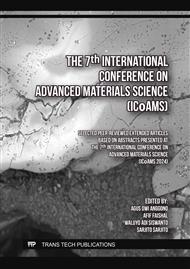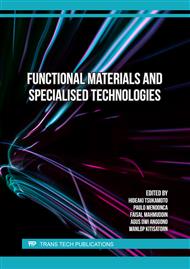[1]
Z. Z. Chun Yang Yin, Sharifah Aishah Syed Abdul Kadir, Ying Pei Lim, Sharifah Nawirah Syed-Ariffin, "An Investigation into Physicochemical Characteristics of Ash Produced from Combustion of Oil Palm Biomass Waste in Boiler," Fuel Process. Technol., vol. 89, no. 7, p.693–696, 2008.
DOI: 10.1016/j.fuproc.2007.12.012
Google Scholar
[2]
F. C. Pa, A. Chik, and M. F. Bari, "Palm Ash as an Alternative Source for Silica Production," MATEC Web Conf., vol. 78, 2016.
DOI: 10.1051/matecconf/20167801062
Google Scholar
[3]
N. Bukit, E. M. Ginting, E. A. Hutagalung, E. Sidebang, E. Frida, and B. F. Bukit, "Preparation and characterization of oil palm ash from boiler to nanoparticle," Rev. Adv. Mater. Sci., vol. 58, no. 1, p.195–200, 2019.
DOI: 10.1515/rams-2019-0023
Google Scholar
[4]
W. K. Setiawan and K. Y. Chiang, "Crop Residues as Potential Sustainable Precursors for Developing Silica Materials: A Review," Waste and Biomass Valorization, vol. 12, no. 5, p.2207–2236, 2021.
DOI: 10.1007/s12649-020-01126-x
Google Scholar
[5]
İ. SUGÖZÜ and B. SUGÖZÜ, "Investigation of Usage of Milled Pine Cone in Brake Pads," Int. J. Automot. Sci. Technol., vol. 4, no. 4, p.253–257, 2020.
DOI: 10.30939/ijastech..770050
Google Scholar
[6]
F. Akbulut et al., "Investigation of Tribological Properties of Brake Friction Materials Developed from Industrial Waste Products," Int. J. Automot. Sci. Technol., vol. 7, no. 4, p.309–315, 2023.
DOI: 10.30939/ijastech..1373026
Google Scholar
[7]
A. Wongpayakyotin, C. Jubsilp, S. Tiptipakorn, P. Mora, C. W. Bielawski, and S. Rimdusit, "Effects of alkyl-substituted polybenzoxazines on tribological properties of non-asbestos composite friction materials," Polymers (Basel)., vol. 13, no. 4, p.1–13, 2021.
DOI: 10.3390/polym13040567
Google Scholar
[8]
H. Kiliç and C. Misirli, "Investigation of tribological behavior of 20NiCrBSi-WC12Co coated brake disc by HVOF method," Mater. Res. Express, vol. 7, no. 1, 2020.
DOI: 10.1088/2053-1591/ab61be
Google Scholar
[9]
H. Yavuz, "Effect of limestone usage on tribological properties in copper and asbestos-free brake friction materials," Ind. Lubr. Tribol., vol. 75, no. 2, p.238–245, 2023.
DOI: 10.1108/ILT-11-2022-0319
Google Scholar
[10]
O. R. Adetunji, A. M. Adedayo, S. O. Ismailia, O. U. Dairo, I. K. Okediran, and O. M. Adesusi, "Effect of silica on the mechanical properties of palm kernel shell based automotive brake pad," Mech. Eng. Soc. Ind., vol. 2, no. 1, p.7–16, 2022.
DOI: 10.31603/mesi.6178
Google Scholar
[11]
J. W. C. Jeesu Park, Hyewon Hwang, Jae Young Kim, "Applicability of Lignin Polymers for Automobile Brake Pads as Binder and Filler Materials and Their Performance Characteristics," Environ. Technol., vol. 41, no. 4, p.1–10, 2020.
DOI: 10.1080/09593330.2018.1503338
Google Scholar
[12]
Y. A. Shuaibu, S. E. Ameh, J. A. Abubakar, A. J. Musa, and G. M. Abubakar, "Development of Asbestos-Free Brake Pad Using Coconut Shell Powder and Coconut Shell Ash As Filler Materials With Gum Arabic As The Binder," Int. J. Innov. Eng. Res. Technol., vol. 10, no. 4, p.112–120, 2023.
DOI: 10.14738/aivp.106.13534
Google Scholar
[13]
T. Singh, "Utilization of Cement Bypass Dust in the Development of Sustainable Automotive Brake Friction Composite," Arab. J. Chem., vol. 14, no. 103324, p.1–12, 2021.
DOI: 10.1016/j.arabjc.2021.103324
Google Scholar
[14]
T. Singh, "Comparative Performance of Barium Sulphate and Cement by-pass Dust on Tribological Properties of Automotive Brake Friction Composite," Alexandria Eng. J., vol. 72, p.339–349, 2023.
DOI: 10.1016/j.aej.2023.04.010
Google Scholar
[15]
T. Grigoratos, REGULATION on Brake/Tire Composition. Elsevier: Amsterdam, The Netherlands, 2018.
Google Scholar
[16]
C. Mohd Ruzaidi, H. Kamarudin, S. Baharin Jamaludin, J. Shamsul, Am. Al Bakri, and A. Alida, "Morphology and Wear Properties of Palm Ash and PCB Waste Brake Pad," Int. Conf. Asia Agric. Anim., vol. 13, no. May, p.145–149, 2011, [Online]. Available: https://www.researchgate.net/publication/265826376.
Google Scholar
[17]
C. M. Ruzaidi, H. Kamarudin, J. B. Shamsul, A. M. M. Al Bakri, and A. R. Rafiza, "Effect of palm slag filler size on the mechanical and wear properties of brake pad composites," Adv. Sci. Lett., vol. 19, no. 1, p.118–122, 2013.
DOI: 10.1166/asl.2013.4711
Google Scholar
[18]
N. A. Abdul Khoni, C. M. Ruzaidi Ghazali, and M. M. Al Bakri Abdullah, "Friction and Braking Application of Unhazardous Palm Slag Brake Pad Composite," IOP Conf. Ser. Mater. Sci. Eng., vol. 343, no. 1, 2018.
DOI: 10.1088/1757-899X/343/1/012014
Google Scholar
[19]
A. D. Anibaba, N. O. Adekunle, B. U. Anyanwu, and J. O. Akinyele, "Investigation of The Potentials of Sisal-Palm Slag Composites as Materials for Asbestos-Free Brake Pad," Comput. Exp. Res. Mater. Renew. Energy, vol. 7, no. 1, p.39, 2024.
DOI: 10.19184/cerimre.v7i1.45149
Google Scholar
[20]
P. Nawangsari, Jamasri, and H. S. B. Rochardjo, "Effect of Phenolic Resin on Density, Porosity, Hardness, Thermal Stability, and Friction Performance as A Binder in Non-Asbestos Organic Brake Pad," IOP Conf. Ser. Mater. Sci. Eng., vol. 547, no. 1, 2019.
DOI: 10.1088/1757-899X/547/1/012012
Google Scholar
[21]
P. Nawangsari, Jamasri, H. S. B. Rochardjo, and A. T. Waskito, "BaSO4-friction dust filler improves friction characteristic in non-asbestos brake pad composite," Int. Rev. Mech. Eng., vol. 13, no. 9, p.513–522, 2019.
DOI: 10.15866/ireme.v13i9.17669
Google Scholar
[22]
E. S. Nelson, S. Iyuke, M. O. Daramola, and A. Okewale, "Extraction and Characterization of Silica from Empty Palm Fruit Bunch (EPFB) Ash," Processes, vol. 11, no. 6, p.1–14, 2023.
DOI: 10.3390/pr11061684
Google Scholar
[23]
K.L. Sundarkrishnaa, "Friction Material Composites," Springer Ser. Mater. Sci., vol. 171, Feb. 2013.
DOI: 10.1524/zkri.1990.190.3-4.315
Google Scholar
[24]
S. Jeganmohan, B. Sugozu, M. Kumar, and D. R. Selvam, "Experimental Investigation on the Friction and Wear Characteristics of Palm Seed Powder Reinforced Brake Pad Friction Composites," J. Inst. Eng. Ser. D, vol. 101, no. 1, p.61–69, 2020.
DOI: 10.1007/s40033-020-00210-9
Google Scholar
[25]
B. Bhatt, U. Marathe, S. Yadav, B. Lochab, and J. Bijwe, "Eco-friendly Polybenzoxazine (PBZ) resins to address the age-old challenge.pdf," Compos. Part B, vol. 11396, no. 278, p.1–18, 2024.
DOI: 10.1016/j.compositesb.2024.111396
Google Scholar
[26]
Y. Cheol, M. Hyung, S. Jin, and H. Jang, "The effect of phenolic resin , potassium titanate , and CNSL on the tribological properties of brake friction materials," vol. 264, p.204–210, 2008.
DOI: 10.1016/j.wear.2007.03.004
Google Scholar
[27]
K. H. Cho, M. H. Cho, S. J. Kim, and H. Jang, "Tribological properties of potassium titanate in the brake friction material; morphological effects," Tribol. Lett., vol. 32, no. 1, p.59–66, 2008.
DOI: 10.1007/s11249-008-9362-x
Google Scholar
[28]
G. Saikrishnan, L. S. Jayakumari, R. Vijay, and D. Lenin Singaravelu, "Influence of iron–aluminum alloy on the tribological performance of non-asbestos brake friction materials – a solution for copper replacement," Ind. Lubr. Tribol., vol. 72, no. 1, p.66–78, 2020.
DOI: 10.1108/ILT-12-2018-0441
Google Scholar
[29]
S. K. G. Santosh Kumar, "Porosity and tribological performance analysis on new developed metal.pdf," J. Manuf. Process, vol. 59, p.186–204, 2020.
Google Scholar
[30]
I. Mutlu, I. Sugözü, and A. Keskin, "The effects of porosity in friction performance of brake pad using waste tire dust," vol. 25, no. 5, p.440–446, 2015.
DOI: 10.1590/0104-1428.1860
Google Scholar
[31]
Y. Liu, Y. Ma, J. Yu, J. Zhuang, S. Wu, and J. Tong, "Development and characterization of alkali treated abaca fiber reinforced friction composites," Compos. Interfaces, vol. 6440, no. May, p.1–16, 2018.
DOI: 10.1080/09276440.2018.1472456
Google Scholar
[32]
F. Wang and Y. Liu, "Mechanical and tribological properties of ceramic-matrix friction materials with steel fiber and mullite fiber," J. Mater., vol. 57, p.449–455, 2014.
DOI: 10.1016/j.matdes.2014.01.017
Google Scholar



